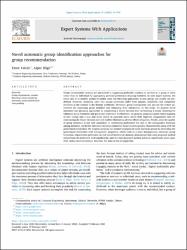| dc.contributor.author | Yalcin Emre | |
| dc.contributor.author | Bilge Alper | |
| dc.date.accessioned | 2022-05-05T11:50:06Z | |
| dc.date.available | 2022-05-05T11:50:06Z | |
| dc.date.issued | 2021 | tr |
| dc.identifier.uri | https://www.sciencedirect.com/science/article/abs/pii/S0957417421001500 | |
| dc.identifier.uri | https://hdl.handle.net/20.500.12418/12642 | |
| dc.description.abstract | Group recommender systems are specialized in suggesting preferable products or services to a group of users rather than an individual by aggregating personal preferences of group members. In such expert systems, the initial task is to identify groups of similar users via clustering approaches as user groups are usually not predefined. However, clustering users into groups commonly suffer from sparsity, scalability, and complexity problems as the content in the domain proliferate. Moreover, group homogeneity and size are the critical parameters for organizing group members and enhancing their satisfaction. In this study, we propose novel automatic user grouping approaches by constructing a binary decision tree via bisecting k-means clustering for enhanced group formation and group size restriction. Furthermore, we propose adopting a genre-based mapping of user ratings into a tiny and dense vector to represent users, which both improves computation time for constructing the binary decision tree and enables eliminating adverse effects of sparsity. Finally, since the quality of group formation is not only dependent on conforming preferences but also to the demographic harmony among members, we further introduce utilizing similarities based on demographic characteristics along with the genre-based similarities. We propose applying two distinct strategies for small and large groups by decorating the genre-based similarities with demographic properties, which leads to a more homogeneous automatic group formation. Experiments performed on real-world benchmark datasets demonstrate that each proposed method outperforms its traditional rival significantly, and the final proposed method achieves significantly more qualified ranked recommendation lists than the state-of-the-art algorithm. | tr |
| dc.language.iso | eng | tr |
| dc.publisher | Elsevier | tr |
| dc.relation.isversionof | 10.1016/j.eswa.2021.114709 | tr |
| dc.rights | info:eu-repo/semantics/restrictedAccess | tr |
| dc.subject | Group recommender systems | tr |
| dc.subject | Bisecting k-means clustering | tr |
| dc.subject | Automatic group identification | tr |
| dc.subject | User-profiling | tr |
| dc.title | Novel automatic group identification approaches for group recommendation | tr |
| dc.type | article | tr |
| dc.relation.journal | Expert Systems with Applications | tr |
| dc.contributor.department | Mühendislik Fakültesi | tr |
| dc.contributor.authorID | 0000-0003-3818-6712 | tr |
| dc.identifier.volume | 174 | tr |
| dc.identifier.startpage | 114709 | tr |
| dc.relation.publicationcategory | Uluslararası Hakemli Dergide Makale - Kurum Öğretim Elemanı | tr |















